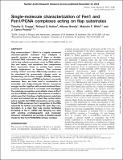Files in this item
Single-molecule characterization of Fen1 and Fen1/PCNA complexes acting on flap substrates
Item metadata
| dc.contributor.author | Craggs, Timothy David | |
| dc.contributor.author | Brenlla, Alfonso | |
| dc.contributor.author | Hutton, Richard David | |
| dc.contributor.author | White, Malcolm F | |
| dc.contributor.author | Penedo, Carlos | |
| dc.date.accessioned | 2013-12-05T12:01:02Z | |
| dc.date.available | 2013-12-05T12:01:02Z | |
| dc.date.issued | 2014-02 | |
| dc.identifier.citation | Craggs , T D , Brenlla , A , Hutton , R D , White , M F & Penedo , C 2014 , ' Single-molecule characterization of Fen1 and Fen1/PCNA complexes acting on flap substrates ' , Nucleic Acids Research , vol. 42 , no. 3 , pp. 1857-1872 . https://doi.org/10.1093/nar/gkt1116 | en |
| dc.identifier.issn | 0305-1048 | |
| dc.identifier.other | PURE: 75722436 | |
| dc.identifier.other | PURE UUID: 0048b132-d002-487a-b096-d45b863c337f | |
| dc.identifier.other | WOS: 000331138800042 | |
| dc.identifier.other | Scopus: 84896729143 | |
| dc.identifier.other | ORCID: /0000-0003-1543-9342/work/47136108 | |
| dc.identifier.other | ORCID: /0000-0002-5807-5385/work/74872759 | |
| dc.identifier.uri | https://hdl.handle.net/10023/4269 | |
| dc.description | This article was made OA through RCUK block grant funds. | en |
| dc.description.abstract | Flap endonuclease 1 (Fen1) is a highly conserved structure-specific nuclease that catalyses a specific incision to remove 5′ flaps in double-stranded DNA substrates. Fen1 plays an essential role in key cellular processes, such as DNA replication and repair, and mutations that compromise Fen1 expression levels or activity have severe health implications in humans. The nuclease activity of Fen1 and other FEN family members can be stimulated by processivity clamps such as proliferating cell nuclear antigen (PCNA); however, the exact mechanism of PCNA activation is currently unknown. Here, we have used a combination of ensemble and single-molecule Förster resonance energy transfer together with protein-induced fluorescence enhancement to uncouple and investigate the substrate recognition and catalytic steps of Fen1 and Fen1/PCNA complexes. We propose a model in which upon Fen1 binding, a highly dynamic substrate is bent and locked into an open flap conformation where specific Fen1/DNA interactions can be established. PCNA enhances Fen1 recognition of the DNA substrate by further promoting the open flap conformation in a step that may involve facilitated threading of the 5′ ssDNA flap. Merging our data with existing crystallographic and molecular dynamics simulations we provide a solution-based model for the Fen1/PCNA/DNA ternary complex. | |
| dc.language.iso | eng | |
| dc.relation.ispartof | Nucleic Acids Research | en |
| dc.rights | © The Author(s) 2013. Published by Oxford University Press. This is an Open Access article distributed under the terms of the Creative Commons Attribution License (http://creativecommons.org/licenses/by/3.0/), which permits unrestricted reuse, distribution, and reproduction in any medium, provided the original work is properly cited. | en |
| dc.subject | Flap endonuclease 1 (Fen1) | en |
| dc.subject | Proliferating cell nuclear antigen (PCNA) | en |
| dc.subject | Förster resonance energy transfer | en |
| dc.subject | Fluorescence enhancement | en |
| dc.subject | QH426 Genetics | en |
| dc.subject.lcc | QH426 | en |
| dc.title | Single-molecule characterization of Fen1 and Fen1/PCNA complexes acting on flap substrates | en |
| dc.type | Journal article | en |
| dc.contributor.sponsor | BBSRC | en |
| dc.contributor.sponsor | BBSRC | en |
| dc.description.version | Publisher PDF | en |
| dc.contributor.institution | University of St Andrews. School of Physics and Astronomy | en |
| dc.contributor.institution | University of St Andrews. Biomedical Sciences Research Complex | en |
| dc.contributor.institution | University of St Andrews. School of Biology | en |
| dc.identifier.doi | https://doi.org/10.1093/nar/gkt1116 | |
| dc.description.status | Peer reviewed | en |
| dc.identifier.grantnumber | BB/E014674/1 | en |
| dc.identifier.grantnumber | BB/D001439/1 | en |
This item appears in the following Collection(s)
Items in the St Andrews Research Repository are protected by copyright, with all rights reserved, unless otherwise indicated.

